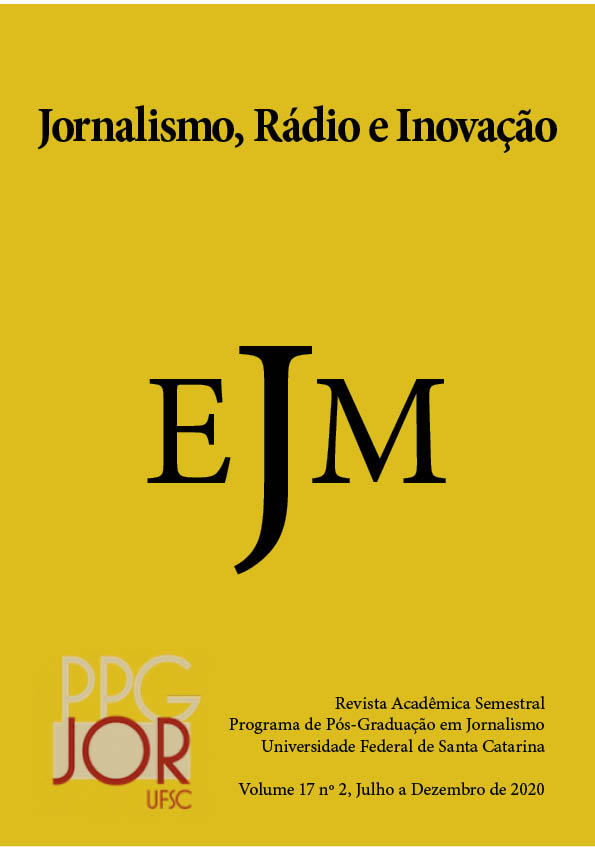Jornalismo e Mito
Fundamentos de uma Crise Simbólica
DOI:
https://doi.org/10.5007/1984-6924.2020v17n2p138Resumo
Este trabalho se desafia a compreender as transformações no imaginário do Jornalismo na passagem do período industrial para o pós-industrial, quando a mídia de massas dá lugar à massa de mídias. Para tanto, busca ampliar o olhar das Teorias do Jornalismo a partir do aporte da Teoria Geral do Imaginário, de modo a compreender as variâncias e reminiscências nas imagens que permeiam o campo epistemológico deste objeto em crise. A leitura simbólica foi construída a partir da mitocrítica de obras clássicas para a epistemologia do jornalismo no Brasil, ainda em seu momento industrial, servindo como fundamento para tensionar as dinâmicas pós-industriais. A análise nos permitiu compreender que as imagens que constelam no imaginário do jornalismo são dinamizadas a partir de suas respostas imaginantes a pulsões ancestrais: Mitos do Tempo, Mitos Especulares, Mitos do Progresso e Mitos da Ordem. A partir deste arcabouço simbólico-mítico, delineamos as imagens evocadas pelo contemporâneo.
Referências
ANDERSON, C.W; BELL, Emily; SHIRKY, Clay. Post-Industrial Journalism – Adapting to the Present. New York: Tow Center, 2012. Relatório. Disponível em: https://academiccommons.columbia.edu/doi/10.7916/D8N01JS7. Acesso em: 19 abr 2020.
ARAÚJO, A. F. Da mitocrítica à mitanálise: um contributo metodológico em educação. In: ARAÙJO, A. F.; GOMES, E. S.; ALMEIDA, R. O mito revivido. São Paulo: Képos, 2014. p. 17-54.
BARBOSA, R. A imprensa e o dever da verdade. São Paulo: Com-Arte; Editora da Universidade de São Paulo, 1990.
BARROS, A. T. M. P. Comunicação e imaginário – uma proposta mitodológica. In: Intercom – Revista brasileira de ciências da comunicação. v. 33. n. 2, 2010.
BRANDÃO, J. S. Mitologia Grega. v. 1. Petrópolis: Vozes, 1986.
BELTRÃO, L. Iniciação à Filosofia do Jornalismo. 2. ed. São Paulo: EDUSP, 2003.
BRIGGS, A.; BURKE, P. Uma história social da mídia. Rio de Janeiro: Zahar, 2006.
CONTRERA, M. O Titanismo na Comunicação e na Cultura: os maiores e os melhores do mundo. COMPOS, 2004.
DURAND, G. As estruturas antropológicas do imaginário. 4. ed. São Paulo: Martins Fontes, 2012.
DURAND, G. Ciência do homem e tradição. São Paulo: Triom, 2008.
DURAND, G. O imaginário. Rio de Janeiro: Difel, 2004.
DURAND, G. Campos do Imaginário. Lisboa: Instituto Piaget, 1998.
FARIA, D. L. Imagens do pai na mitologia. In: Psi. Rev., São Paulo, v. 1, n. 15, p. 45-58, 2006.
GALIMBERTI, U. O Homem na Idade da Técnica. São Paulo: Paulus: 2006.
GENRO FILHO, A. O segredo da pirâmide. Florianópolis: Insular, 2012.
HAYLES, K. Chaos and order: complex dynamics in literature and science. Chicago: University Press, 1991
JAEGER, M. A aposta de Fausto e o processo da Modernidade. In: Estudos Avançados, v. 21, n. 59, 2007. Disponível em: http://www.revistas.usp.br/eav/article/view/10225/11839 Acesso em: 18 abr. 2020. Acesso em: 06 jan. 2019.
JOBIM, D. Espírito do Jornalismo. São Paulo: EdUSP, 1992.
LAGE, N. Ideologia e técnica da notícia. Florianópolis: Insular, 2012.
LIMA SOBRINHO, B. O problema da imprensa. São Paulo: EdUSP, 2008
MEDINA, C. Fundamentos epistemológicos da informação jornalística. 54 p. Tese (Titular). Escola de Comunicação e Artes, Universidade de São Paulo, São Paulo, 1993.
MEDINA, C. Notícia – um produto a venda. São Paulo: Editora Alfa Ômega, 1978.
MORIN, E. A cabeça bem-feita. Rio de Janeiro: Bertrand Brasil, 2000.
TÁVOLA, A. Comunicação é mito. Rio de Janeiro: Nova Fronteira, 1985.
Downloads
Publicado
Edição
Seção
Licença
Ao encaminhar textos à revista Estudos em Jornalismo e Mídia, o autor estará cedendo integralmente seus direitos patrimoniais da obra à publicação, permanecendo detentor de seus direitos morais (autoria e identificação na obra), conforme estabelece a legislação específica. O trabalho publicado é considerado colaboração e, portanto, o autor não receberá qualquer remuneração para tal, bem como nada lhe será cobrado em troca para a publicação. As ideias e opiniões expressas no artigo são de exclusiva responsabilidade do autor, não refletindo, necessariamente, as opiniões da revista. Citações e transcrições são permitidas mediante menção às fontes. A revista Estudos em Jornalismo e Mídia está sob a Licença Creative Commons



